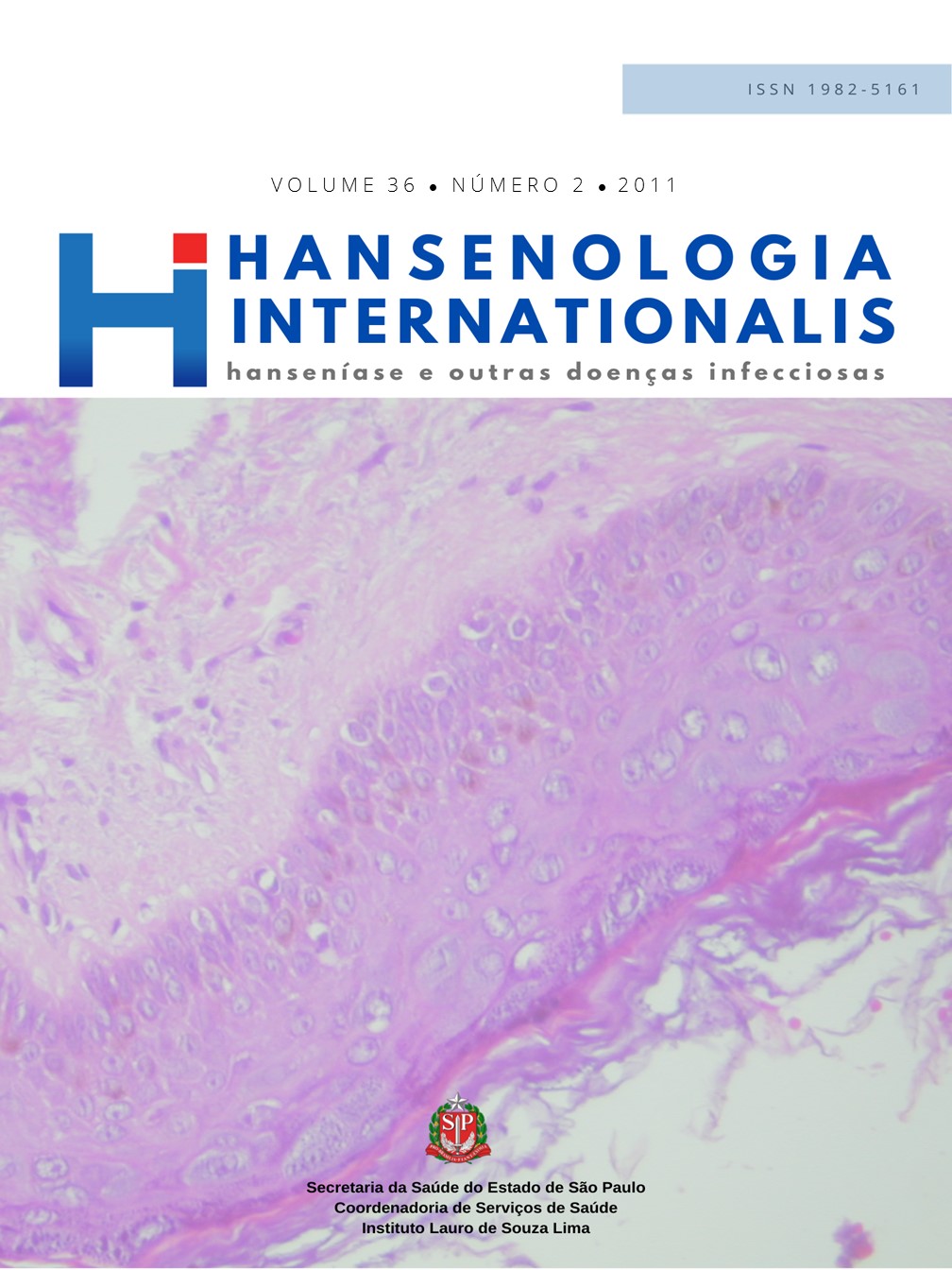Abstract
The aim of this study was to identify the detection rates and prevalence of leprosy in the Bragança Paulista city (SP) in the period 1999-2006, outlining the predominantform of the disease, and comparing the degree of disability reported in the diagnosis and end treatment. Information was collected from medical records, in the notification records in the SINAN and DATASUS databases (n=171). Were performed qualitative and quantitative analyses using the chi-square test (p ≤ 0.01). 171 records were analyzed, only 47% of these patients had been evaluated at diagnosis and discharged as cured. The investigation of the degree of disability of patients evaluated at diagnosis and discharge, showed that in the right eye 10.4% worsened and 34.8% of patients with disabilities in the diagnosis improved (p = 0). In the left eye, 8.6% worsened and 39.1% of patients with grade I or II in diagnosis improved (p = 0). On the right hand, 9.4% worsened and 18.7% of those with grade I or II improved (p = 0). In his left hand, 7.7% worsened and 37.5% of which were grade I or II showed improvement (p = 0). In the right foot, 20% showed worsening under disability and 30.3% of those with grade I or II in diagnosis improved (p = 0). In the left foot, 28.6% worsened and 28.2% of those with grade I or II improved (p = 0). The patients evaluated in the diagnosis and discharge had significant reductions in degrees of disability in the eyes, hands and feet, suggesting that preventive actions can have an impact on prevention of disabilities.
References
2 Brasil. Ministério da Saúde, Programa Nacional de Controle da Hanseníase. Informe Epidemiológico, 2008.
3 World Health Organization. Global leprosy situation, beginning of 2008. Weekly Epidemiological Record, 2008;83:293-300.
4 Brasil. Ministério da Saúde. Secretaria de Vigilância em Saúde. Departamento de Vigilância Epidemiológica: Manual de prevenção de incapacidades. 3. ed., 2008.
5 Pereira HLA, Ribeiro, SLE, Ciconelli, RM, Fernandes ARC. Avaliação por imagem do comprometimento osteoarticular e de nervos periféricos na hanseníase. Rev. Bras. Reumatol. 2006; 46(supl):30-35.
6 Gonçalves SD, Sampaio RS, Antunes, CMF. Fatores preditivos de incapacidades em pacientes com hanseníase. Rev Saúde Pública 2009; 43(2):267-74.
7 Rodini FCB, Gonçalves M, Barros ARSB, Mazzer N, Elui VMC, Fonseca MCR. Prevenção de incapacidade na hanseníase com apoio em um manual de autocuidado para pacientes. Fisioterapia e Pesquisa, 2010; 17(2):157-66.
8 Virmond MCL. Alguns apontamentos sobre a história da prevenção de incapacidades e reabilitação em hanseníase no Brasil. Hansen Int. 2008; 33(2). Suppl. 1 p. 13-8.
9 Moreira D, Alvarez RRA, Machado ELS, Costa RAG.; Nascimento RR, Santos RAM, Oliveira RS. A importância da
avaliação de incapacidades em membros superiores de pacientes portadores de hanseníase atendidos em nível ambulatorial. Fisioterapia em Movimento, 2001; 14(1):21- 24.
10 Cury MRCO, Paschoal VDA, NardiI SMT, Chierottil AP, Júnior ALR, Chiaravalloti-Neto F. Análise espacial da incidência de hanseníase e fatores socioeconômicos associados. Rev Saúde Pública 2012;46(1):110-8.
11 Gomes, CCD; Pontes, MAA; Gonçalves, HS; Penna, GO; Andrade, ALSS. Perfil clínico epidemiológico dos pacientes diagnosticados com hanseníase em um centro de referência na região Nordeste do Brasil. Anais Brasileiros de Dermatologia. 2005; 80(Supl):283-288.
12 Façanha MC, Pinheiro AC, Lima JRC, Ferreira MLLT, Teixeira GFD, Rouquayrol MZ. Hanseníase: subnotificação de casos em Fortaleza – Ceará, Brasil. Anais de Dermatologia. 2006; 81(4):329-333.
13 Corrêa CMJ, Ivo ML, Honer M.R. Incapacidades em sujeitos com hanseníase em um centro de referência do centrooeste brasileiro entre 2000-2002. Hansen int 2006; 31 (2):21-8.
14 Vieth H, Saloti SRA, Passearotti S. Guia de prevenção ocular em hanseníase, Talmilep, Teaching and learning materials in leprosy. 1994; 54p.
15 Opromolla, DVA. Hanseníase após a cura. 1998; Hansen. Int., 23(1/2):1-2.
16 World Health Organization (WHO/OMS). Guia para la eliminacion de la lepra como problema de salud publica. WHO/Programa de Acción para la Eliminación da la Lepra, Genebra, 1995.
17 Virmond M, Vieth H. Prevenção de Incapacidades em Hanseníase: Uma análise crítica. Medicina, Ribeirão Preto, Simpósio: HANSENÍASE. 1997; 358-363.
18 Taylor MA, Amir N. Sinister psychotics. Left-handedness in schizophrenia and affective disorder. J Nerv Ment Dis. 1995; 183:9-13.
19 Garbino J.A. Manejo clínico das diferentes formas de comprometimento da neuropatia hanseniana. Hansen. Int., p.9399,1998. Número especial.
20 Stump PRNAG, Garbing JA, Zulian EA. Reabilitação em hanseníase. In: Lianza S. Medicina de reabilitação. Rio de Janeiro: Guanabara Koogan, 1984. p.355-65

This work is licensed under a Creative Commons Attribution 4.0 International License.
